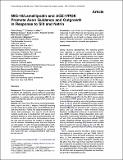| dc.contributor.author | Chang, Chieh | |
| dc.contributor.author | Adler, Carolyn E. | |
| dc.contributor.author | Krause, Matthias | |
| dc.contributor.author | Clark, Scott G. | |
| dc.contributor.author | Tessier-Lavigne, Marc | |
| dc.contributor.author | Bargmann, Cornelia I. | |
| dc.contributor.author | Gertler, Frank | |
| dc.date.accessioned | 2014-01-06T14:37:11Z | |
| dc.date.available | 2014-01-06T14:37:11Z | |
| dc.date.issued | 2006-04 | |
| dc.date.submitted | 2006-03 | |
| dc.identifier.issn | 09609822 | |
| dc.identifier.issn | 1879-0445 | |
| dc.identifier.uri | http://hdl.handle.net/1721.1/83476 | |
| dc.description.abstract | Background:
The cytoplasmic C. elegans protein MIG-10 affects cell migrations and is related to mammalian proteins that bind phospholipids and Ena/VASP actin regulators. In cultured cells, mammalian MIG-10 promotes lamellipodial growth and Ena/VASP proteins induce filopodia.
Results:
We show here that during neuronal development, mig-10 and the C. elegans Ena/VASP homolog unc-34 cooperate to guide axons toward UNC-6 (netrin) and away from SLT-1 (Slit). The single mutants have relatively mild phenotypes, but mig-10; unc-34 double mutants arrest early in development with severe axon guidance defects. In axons that are guided toward ventral netrin, unc-34 is required for the formation of filopodia and mig-10 increases the number of filopodia. In unc-34 mutants, developing axons that lack filopodia are still guided to netrin through lamellipodial growth. In addition to its role in axon guidance, mig-10 stimulates netrin-dependent axon outgrowth in a process that requires the age-1 phosphoinositide-3 lipid kinase but not unc-34.
Conclusions:
mig-10 and unc-34 organize intracellular responses to both attractive and repulsive axon guidance cues. mig-10 and age-1 lipid signaling promote axon outgrowth; unc-34 and to a lesser extent mig-10 promote filopodia formation. Surprisingly, filopodia are largely dispensable for accurate axon guidance. | en_US |
| dc.description.sponsorship | National Institutes of Health (U.S.) (Grant GM68678) | en_US |
| dc.description.sponsorship | Howard Hughes Medical Institute | en_US |
| dc.language.iso | en_US | |
| dc.publisher | Elsevier | en_US |
| dc.relation.isversionof | http://dx.doi.org/10.1016/j.cub.2006.03.083 | en_US |
| dc.rights | Article is made available in accordance with the publisher's policy and may be subject to US copyright law. Please refer to the publisher's site for terms of use. | en_US |
| dc.source | Elsevier Open Archive | en_US |
| dc.title | MIG-10/Lamellipodin and AGE-1/PI3K Promote Axon Guidance and Outgrowth in Response to Slit and Netrin | en_US |
| dc.type | Article | en_US |
| dc.identifier.citation | Chang, Chieh, Carolyn E. Adler, Matthias Krause, Scott G. Clark, Frank B. Gertler, Marc Tessier-Lavigne, and Cornelia I. Bargmann. “MIG-10/Lamellipodin and AGE-1/PI3K Promote Axon Guidance and Outgrowth in Response to Slit and Netrin.” Current Biology 16, no. 9 (May 2006): 854-862. Copyright © 2006 Elsevier Ltd. | en_US |
| dc.contributor.department | Massachusetts Institute of Technology. Department of Biology | en_US |
| dc.contributor.department | Koch Institute for Integrative Cancer Research at MIT | en_US |
| dc.contributor.mitauthor | Krause, Matthias | en_US |
| dc.contributor.mitauthor | Gertler, Frank | en_US |
| dc.relation.journal | Current Biology | en_US |
| dc.eprint.version | Final published version | en_US |
| dc.type.uri | http://purl.org/eprint/type/JournalArticle | en_US |
| eprint.status | http://purl.org/eprint/status/PeerReviewed | en_US |
| dspace.orderedauthors | Chang, Chieh; Adler, Carolyn E.; Krause, Matthias; Clark, Scott G.; Gertler, Frank B.; Tessier-Lavigne, Marc; Bargmann, Cornelia I. | en_US |
| dc.identifier.orcid | https://orcid.org/0000-0003-3214-4554 | |
| mit.license | PUBLISHER_POLICY | en_US |
| mit.metadata.status | Complete | |
